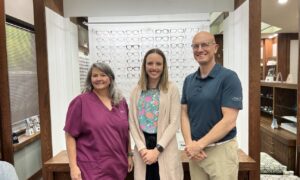By Chad Fleming, OD, FAAO

Dec. 19, 2018
Your patients visit you for your expertise and the products you sell, not to have a morning or afternoon taken up. When patient visits are more efficient, your practice becomes more profitable because you can see more patients per day, or have more time for thorough exam-room conversations.
Here are a few key improvements my practice made to increase efficiency in patient flow.
How Long Should a Patient Visit Take?
The average time of patient visits should be under an hour, but we do have instances where patients are in the office longer than that. We have slowly been expediting the exam process to meet the needs of modern-day patients. We point out to staff that patients used to think a long time at the doctor’s office meant great comprehensive care, but now we will get a negative review online if patients are in the office, or have to wait, too long.
Time Your Average Patient’s Visit
In our practice, a patient checks in 15 minutes before they are seen by the doctor. The optometric assistant has 10-15 minutes to work them up for the exam, which usually takes 15 minutes, or less. Then the remaining 15-30 minutes are spent in the optical.
2 Changes to Make
The two main things we have incorporated into the workflow is dilating in pretesting and utilizing wide field photography as an alternative to dilation for the healthy vision wellness patients. Also, delegating more preliminary testing to the staff has helped significantly.
Editor’s Note: The standard of care in optometry is to dilate all patients. If a patient experiences vision loss, and you are not able to show that you recommended that they have their eyes dilated at their most recent exam, you could be found liable for malpractice.
In addition, technology that reduces intake of patients is valuable. If patients can fill out information and update their personal health data prior to the exam, the workflow is much better. We also have all optometric assistants and doctors on laptops or tablets to reduce log-in time and time spent entering data.
Time saved: The dilating in pre-testing has decreased the exam time by 20 minutes for patients needing dilation. We can now dilate more people to be progressive in standards of care and identify disease earlier than what we did 10 years ago when we did not dilate as much. Now almost all patients are either dilated or have the wide field photo done.
Help from a Scribe
All of the exam intake is documented by a scribe and the hand-off from clinic to optical is done by the scribe. The scribe has made it possible to cut all exams to 15 minutes or less and not compromise patient perception. Patients comment that they appreciate that I don’t look at my computer during the complete exam. Out of 15 minutes I use maybe a minute to 90 seconds looking at the computer, otherwise, I delegate all documentation to the scribe.
Re-Focus Exam Room Time
I model prescribing specific ophthalmic lenses and frame types to patients and lead our group of doctors to do the same thing. Prescribe glasses like you do medication. In discussing contact lenses, I use exam-room time to explain to patients why the best option is daily disposable lenses.
Other Articles to Explore
The added time we have to discuss contact lens modalities and care has resulted in 60 percent of my patients using daily disposables and 50 percent of patients of our practice of seven doctors utilizing daily disposables.
Along with contact lens wear and care, I use the the freed-up exam time to discuss issues like digital eye fatigue, focusing on explaining why I am “prescribing” computer glasses. I might say: “I am prescribing the blue light filter AR coating for your eye demands”
Incorporate Patient Communication Tools
Since incorporating patient communication tools (e.g., Weave, Solutionreach, DemandForce, Web3), we have seen patients schedule appointments who haven’t been in for over two years. Patients pick up their glasses and contacts faster with text notifications. Text messaging patients has significantly sped up the communication process, and freed up the time of employees who otherwise would be on the phone for hours contacting patients.
If you are practicing optometry in today’s world, then you must be communicating via e-mail and text messaging. Patients of all ages now expect the ability to communicate by both text and e-mail.
 Chad Fleming, OD, FAAO, is a partner with Wichita Optometry, P. A. in Wichita, Kan. To contact: chad@optometryceo.com
Chad Fleming, OD, FAAO, is a partner with Wichita Optometry, P. A. in Wichita, Kan. To contact: chad@optometryceo.com



























